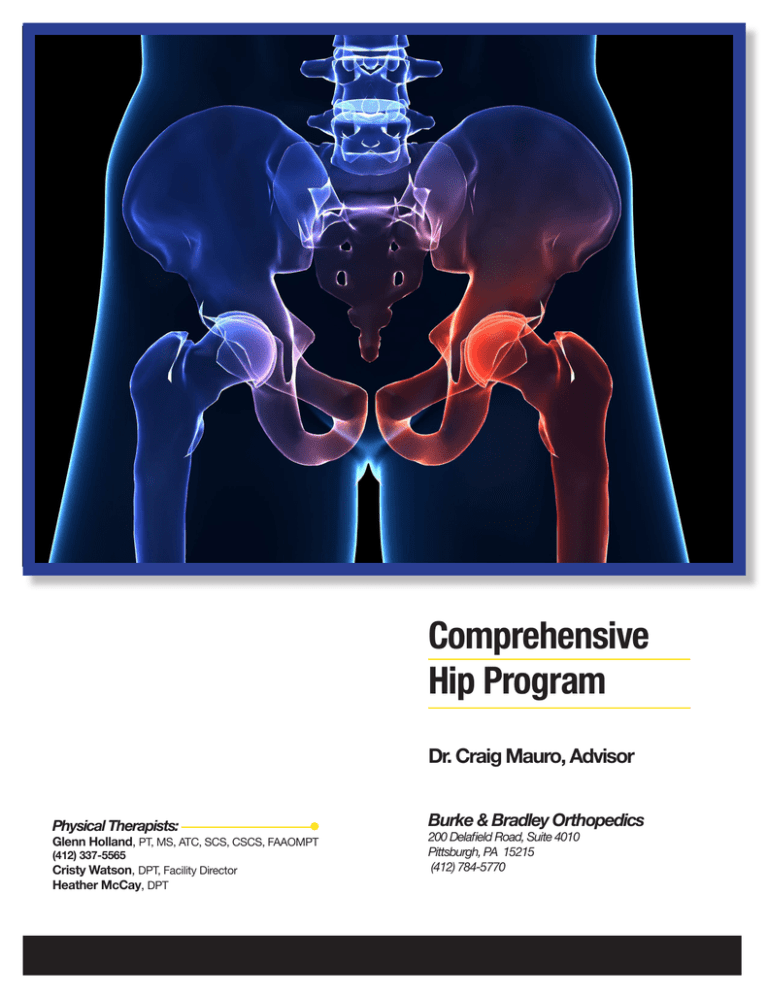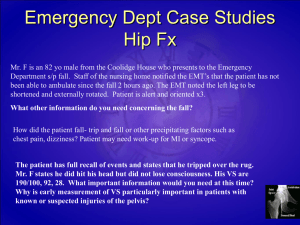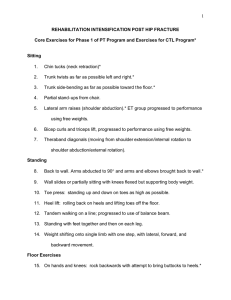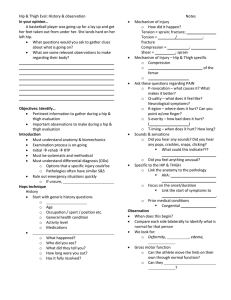
Comprehensive
Hip Program
Dr. Craig Mauro, Advisor
Burke & Bradley Orthopedics
Physical Therapists:
200 Delafield Road, Suite 4010
Pittsburgh, PA 15215
(412) 784-5770
Glenn Holland, PT, MS, ATC, SCS, CSCS, FAAOMPT
(412) 337-5565
Cristy Watson, DPT, Facility Director
Heather McCay, DPT
1
2
Ta b l e o f C o n t e n t s
Discharge instructions for hip surgery with Dr. Mauro..................................................................................... 4-5
Labral Tears of the hip joint............................................................................................................................... 6-7
Exercises after Hip Arthroscopy — Stage 1 ROM......................................................................................................8
Exercises After Hip Arthroscopy — Stage 1 Strengthening.....................................................................................12
Exercises After Hip Arthroscopy — Stage 2 ROM...................................................................................................15
Exercises After Hip Arthroscopy — Stage 2 Strengthening.....................................................................................16
Biographies.................................................................................................................................................... 21-22
3
Discharge instructions with Dr. Mauro
WEEK 0-2
n Post-surgical exercises (No ER>20 degrees)
n Bike 20 minutes/day (can be up to 2x day)
n Scar massage
n Hip PROM
n Supine hip log rolling for hip IR—progressing to
stool rotations AAROM (IR)
n Hip isometrics (no flexion) ER, ABD, ADD, Ext
n Pelvic tilts
n Supine bridge
n NMES to quadriceps with SAQ
n Quadruped rocking for hip flexion
n Sustained stretching for psoas with cryotherapy
(2 pillows under hip)
n Gait training for PWB with assistive device with
flat foot
WEEK 4-8
n Standing BAPS rotations
n ER with FABER
n Hip flexor/gluteus/piriformis/IT band stretching
(manual/self)
n Hip flexion isotonic
n Multi hip machine
n Leg press
n Isokinetic knee flexion/extension
n Front/side planks
n Dynamic balance (foam/bosu ball)
n Side stepping
n Hip hiking
WEEK 0-4
n Bent knee fall outs
n Stool rotations for ER
n Gluteus/piriformis stretch
n Core strengthening
n Hip ABD/Ext isotonics
n Step downs
n Clam Shells
n Hip hiking
n Proprioception/balance training
n Bike/elliptical
n Bilateral cable column rotations
n Treadmill side stepping
Notes:
4
Discharge instructions with Dr. Mauro
WEEK 8-12
n
n
n
n
Progress with hip ROM
Progressive LE and core strengthening
Endurance activities around the hip
Dynamic balance activities
WEEK 12-16
n
n
n
n
Progressive LE and core strengthening
Plyometrics
Treadmill running program
Sport specific drills
Criteria for Discharge
n Hip Outcome Score
n Pain free or at least manageable level of discomfort
n MMT within 10% of uninvolved LE
n Biodex® test of quadriceps and hamstring peak torque within 15% of uninvolved leg
n Single leg cross-over trip hop for distance
n Score of less than 85% are considered abnormal for male and female
n Step down test
5
Fig. 1
A hip labral tear can be difficult to diagnose. Many of the
symptoms of a hip labral tear are similar to symptoms of a
groin strain, snapping hip syndrome, or other athletic injuries
of the hip joint. Furthermore, just because a tear is seen in the
hip labrum on an MRI, it does not mean the tear is necessarily
the cause of the pain.
Typical symptoms of a hip labral tear include:
n Groin
pain
n Clicking and snapping sensations in the hip
n Limited motion of the hip joint
Your doctor can use specific examination tests to help determine the cause of your pain. X-rays of the hip are typically
normal, but should be checked to evaluate for other possible
causes of pain. An MRI test is helpful in evaluating the labrum, but may not always show the labrum clearly. An injection of contrast fluid into the hip joint at the time of the MRI
can help show labral tears much more clearly.
The labrum is a type of cartilage that surrounds the socket of
ball-and-socket joints. A labrum is found in both the shoulder
and the hip joint. The labrum forms a ring around the edge of
the bony socket of the joint. It helps to provide stability to the
joint by deepening the socket, yet unlike bone, it also allows
flexibility and motion.
Many doctors will also use a diagnostic injection to help clarify the location of the problem. To perform a diagnostic injection of the hip joint, your doctor will insert a needle into your
hip joint while watching on an x-ray monitor to ensure the
needle is in the proper position. The hip joint is then injected
with a local anesthetic. If the injection completely alleviates
the symptoms of pain, it is likely that the cause of the problem
was located in the hip joint. If the pain persists, investigation
into the cause of the problem should proceed to other possible
diagnoses.
Injuries to the labrum have long been recognized as a possible
source of pain and discomfort. Labral injuries in the shoulder
are much more common, and the treatment of shoulder labral
injuries has been more carefully investigated. With the recent
development of arthroscopic techniques to surgically manage
the hip joint, there has been increased recognition and awareness of hip labral tears.
The treatment of hip labral tears is evolving quite quickly.
Only a few years ago this injury was rarely recognized. Now
it is becoming increasingly common to hear of athletes having
their “hip scoped” to have their labral tear treated. In general,
the treatment of a hip labral tear usually starts off with some
simple steps.
There are two general types of hip labral tears: degenerative
tears and traumatic injuries. A degenerative tear is a chronic
injury that occurs as a result of repetitive use and activity.
Athletes who participate in such sports as ice hockey, soccer,
football, golf and ballet are at higher risk of developing a hip
labral tear. Structural abnormalities of the hip also can lead to
a hip labral tear.
Degenerative labral tears can be seen in the early stages of hip
arthritis. A traumatic hip labral tear is usually an acute injury
as a result of a sports injury, fall, or accident. Hip labral tears
can be seen in association with episodes of hip dislocation
or subluxation. They are commonly associated with sudden,
twisting maneuvers that cause immediate pain in the hip.
6
Continued
Typical early treatments of a hip labral
tear include:
3 Cortisone Injection
A cortisone injection is useful not only as a treatment of the
labral tear, but it can also be performed at the same time as a
diagnostic injection the help determine the cause of the
hip pain.
3 Rest
The torn labrum in the hip can cause inflammation around the
joint. Allowing the inflammation to settle down may alleviate
the symptoms of the labral tear and allow return to activities.
If these treatments fail to alleviate the pain associated with a
hip labral tear, a hip arthroscopy procedure may be considered.
During a hip arthroscopy, your surgeon places a small camera
into the hip joint to see the labral tear. Your surgeon can also
evaluate the cartilage of the joint, important ligaments, and
other structures.
3 Anti-Inflammatory Medications
Anti-inflammatory medications can be helpful in diminishing some of the inflammation in the joint. If the inflammation
subsides, the symptoms may resolve.
Treatment of the labral tear usually consists of shaving out
the torn portion of the labrum. In some larger tears, located in
an accessible area of the joint, a repair of the labrum may be
attempted. Recovery from a hip arthroscopy depends on the
extent of work that needs to be completed, but usually lasts 6
to 12 weeks. Many people are able to return to sports within
four to six months after the surgery.
3 Physical Therapy
Physical therapists can use various techniques to improve hip
function by strengthening and balancing the muscles around
the hip joint.
7
Bike:
Bike 20 minutes/day progressing to 2 times a day.
Prone Lying:
Lie on your stomach with your legs flat on bed for 20 minutes. Perform 2 times a day.
Prone Hip Internal Rotation:
Lie on your stomach and bend your knees to 90 degrees. Move your feet out to the side then back to the center.
Perform sets of 10 repetitions, 2 times a day.
8
Heel Slides:
Lie on your back or sit with your leg straight. Gently slide your heel toward your hip. Slide your heel back so your
leg is straight. Perform sets of 10 repetitions, 2 times a day.
Stool Rotation For IR:
Stand and place the knee of the involved lower extremity on a step stool with approximately 20% of your body weight.
Rotate your leg outward slowly. Return to starting position. Perform a set of 10 repetitions, 2 times a day.
Quadruped Rocking for Hip Flexion:
Start on your hands and knees with your back flat. Gently rock backward until your buttock is close to you heels.
Limit the backward rock as pain allows. Return to starting position and perform sets of 10 repetitions, 2 times a day.
9
Calf Pumps:
Point and flex your toes to tighten you calf muscles. Perform sets of 10 repetitions, 4 times a day.
Passive ROM (By Therapist)
Circumduction in Flexion:
Lie on your back with your knee bent and your hip flexed about 70 degrees. Have your partner gently rotate your hip
in a clockwise circular “pendulum” motion for 5 minutes. Repeat this rotation in a counter-clockwise direction for
5 minutes. Do this series two times a day.
10
Circumduction in Neutral:
Lie on your back with your leg straight. Have your partner lift and hold your leg at the ankle and slowly rotate your
hip in a clockwise circular motion for 5 minutes. Repeat this rotation in a counter-clockwise direction for 5 minutes.
Do this series two times a day.
L
Internal Rotation:
Lie on your back with your leg straight. Have your partner roll your leg inward and then relax back to the starting
position. Perform sets of 10 repetitions, 2 times a day.
11
Prone Gluteal Setting:
Lie on stomach and place a pillow under your hips. Tighten gluteal muscles (squeeze buttock cheeks together).
Hold for 5 seconds and then relax. Perform sets of 10 repetitions, 2 times a day.
i
Quadriceps setting:
Lie on your back with your legs straight. Tighten your quadriceps muscle by pushing the back of your knee towards
the table. Hold 6 seconds. Perform 10 repetitions, 2 times a day.
12
i
Abdominal Setting:
Lie flat on your back with your first two fingers just inside your pelvic (hip) bone. Relax your abdominal muscles and
take a deep breath in and out. At the end of your exhale, contract your abdominal muscles by drawing your belly button back toward your spine. Hold this contraction through ten normal breaths. Your spine and pelvis should not move.
Perform 2 repetitions, 2 times a day.
Bridging:
Squeeze your buttocks and raise your hips off the table until your trunk is in a straight line. Hold 3 seconds and return
to starting position. Perform 10 repetitions, 2 times a day.
Hip Abduction Isometric:
Lie on your back with your involve leg flexed to 90 degrees. Place a towel between your knee and the wall and gently
push in to the towel. Hold for 6 seconds and then release. Perform 10 repetitions, 2 times a day.
13
i
i
Hip Adduction Isometric:
Lie on your back with your knees flexed to 90 degrees. Place a pillow or ball between your legs. Squeeze your knees
together and hold for 6 seconds. Perform 10 repetitions, 2 times a day.
i
Hip Extension Isometric:
Lie on your back with your legs straight. Push the heel of your involved leg into the table and hold for 6 seconds.
Perform 10 repetitions, 2 times a day.
14
Bent Knee Fall Outs:
Lie on your back with your knees bent and feet flat on the table. Move the knee of your involved hip outwards
45 degrees (a few inches) and return to starting position. Perform a set of 10 reptitions, 2 times a day.
Stool Rotation for ER
Stand and place knee of the involved lower extremity on a step stool with approximately 20% of your body weight.
Rotate your leg inward slowly until heel contacts your oposite leg and return to starting position. Perform a set of 10
repetitions, 2 times a day.
Gluteus/Piriformis stretch:
Lie on a table with both knees flexed to 45 degrees. Place the ankle of your involved leg above the opposite knee.
Clasp your hand under your thigh and slowly pull towards your chest. Hold 20-30 seconds and return to starting
position. Perform a set of 5 repetitions, 2 times a day.
15
ER with FABER:
Lie on your back with legs straight. Place the ankle of your involved leg on your opposite knee. Gently lower your
knee until you feel a stretch or mild pain. Perform 10 repetitions, 2 times per day.
Clam Shells:
Lie on uninvolved side with knees bent at 60 degrees. Keep ankles together and lift knee apart 6-8 inches. Hold 3
seconds and return to starting position. Perform 2 sets of 10 repetitions, 2 times a day.
16
Hip Abduction Isotonics:
Lie on your side in a straight line with your involved leg on top. Lift top leg upward 6-8 inches, hold 3 seconds and
return to starting position. Perform 2 sets of 10 repetitions, 2 times a day.
Hip Extension Isotonics:
Lie face down on floor and lift involved leg 6-8 inches off the floor. Hold 3 seconds and return to starting position.
Perform 2 sets of 10 repetitions, 2 times a day.
Hip Hiking:
Stand on your involved leg on a stool with uninvolved leg unsupported over the edge of the stool. Keep your knees
straight and lower your uninvolved leg toward the floor 3 to 6 inches, then raise or “hike” your hip as high as it will go.
Perform 2 sets of 10 repetitions, 2 times a day.
17
Step Downs:
Stand on a step stool using your involved leg and place your hands on your hips. Slowly lower your uninvolved leg
to the floor until your heel taps the floor keeping your hips level. Return to starting position and perform 2 sets
10 repetitions, 2 times day.
Core Strengthing: (Planks)
Lie face down on floor resting on the forearms, palms flat on the floor. Push off the floor, rasing up onto toes, and
support upper body on forearms. Keep your back flat, in a straight line from head to heels. Tilt your pelvis and
contract your abdominals to prevent your buttocks from sticking up in the air or sagging in the middle. Hold up to
10-20 seconds, lower and repeat for 10 repetitions. Perform 2 sets of 10 repetitions, 2 times a day.
18
Side Planks:
Lie on your side with your elbows flexed, forearm on floor and palm down. Place your head, body in a straight line.
Tighten your stomach muscles and use your feet and shoulder to lift your hips off floor keeping your body in a straight
line. Hold this position for ten seconds and lower your body to initial position. Perform 2 sets of 10, repetitions
2x a day.
Side Stepping:
Stand with your feet shoulder-width apart and place a resistance band around your ankles. Keep your knees slightly
flexed and your back straight. Tighten your stomach muscles and Side-step to your right, keeping your feet shoulderwidth apart as you move in 6 inch steps for 20 feet. Return to starting position by side stepping to left. Perform 5
repetitions, 2 times a day.
19
Cable Column Rotations:
Stand with your feet shoulder width apart and knees slightly flexed. Grasp the cable handle with both hands at the
level of your abdominal muscles. Contract your core muscles and rotate to your left 45 degrees. Hold 3 seconds and
return to starting position. Perform this exercise rotating towards each side for 10 repetitions, 2 times a day.
Single Leg Balance:
Stand on involved leg with hands placed on hips. Balance for 10-20 seconds on floor, pillow, or bosu ball and repeat
five repetitions. Perform 2 sets of 5 repetitions, 2 times a day.
Windmills:
Stand on one leg in an upright position with your arms raised out to the side in a “T” position. Hinge at your hips and
lean forward until your upper body is parallel to floor. Place one hand in front of your foot on the ground. Hold position
for three seconds then repeat with opposite hand. Perform 10 repetitions and then switch legs and repeat. Perform 2 sets
of 10 repetitions, 2 times a day.
20
Physical Therapists Biographies
Glenn Holland, Director of Sports Medicine
PT, MS, ATC, SCS, CSCS, FAAOMPT
Heather McCay,
DPT
Glenn is currently Director of Sports Medicine for the Physical
Therapy Institute where he works with numerous professional
and recreational athletes as well as general orthopaedic
patients. For the past 15 years, Glenn has specialized in
evaluation and treatment of the overhead athlete with a
primary emphasis on baseball players. As a consultant for
baseball injuries in high school, collegiate, and professional
athletes in Western Pennsylvania, he has implemented
rehabilitative programs, throwing programs, and sport-specific
training. Glenn works closely with Dr. Pat McMahon, the
University of Pittsburgh Medical Center Orthopedic Specialist
for shoulder, elbow, and wrist injuries; Dr. James Bradley, the
physician for the Pittsburgh Steelers; and Dr Patrick DeMeo,
Medical Director of the Pittsburgh Pirates. A 1995 graduate of
the University of Pittsburgh Physical Therapy School, Glenn
is a Certified Athletic Trainer and has specialty certifications in
manual therapy and strength and conditioning.
Cristy Watson, Facility Director
DPT
Heather received her bachelor degree in rehabilitation science
from the University of Pittsburgh in 2007. She received her
doctorate of physical therapy from Chatham University in
2009. For the past 2 years, Heather has been employed by
The Physical Therapy Institute treating patients with
orthopedic, sports medicine, and balance and vestibular
disorders. In addition, she has specialized in treating young
athletes who have been injured and is presently developing a
return to sports program for high school and collegiate athletes.
Heather also serves as an consultant for the Washington Wild
Things Baseball Club.
Copyright 2012 © by Glenn Holland, PT
Cristy received her undergraduate Biology degree at
Waynesburg University in 2001 and her doctorate in Physical
Therapy at Chatham University in 2005. Along with her
Physical therapy license, she received her Direct Access
certification in 2009. Cristy is presently working as the Facility
Director of the Physical Therapy Institute in Washington, PA
treating orthopedic, sports medicine, and vestibular conditions
of all ages. She works closely with Dr. Mark Hofbauer and Dr.
DeCarbo, foot & ankle specialists for The Orthopedic Group
as well as a consultant with the Washington Wild Things
Professional Baseball Club.
21
Designed by Dana Patrene-DaPra
Medical Illustration Copyright © 2011 Nucleus Medical Media,
All rights reserved.www.nucleusinc.com
All right reserved. Except for use in a review, the reproduction or utilization in any
form or by any electronic, mechanical, or other means, now known or hereafter
invented, including xerography, photocopying, and recording, and in any information
storage and retrieval system, is forbidden without the written permission of the
publisher.
MD Biography
Craig S. Mauro, MD
Dr. Mauro is a Pittsburgh native and graduated from
Fox Chapel Area High School. A soccer, basketball, and
baseball player for Fox Chapel, he has been inducted
into the Fox Chapel Area Schools Sports Hall of Fame.
At Cornell University, Dr. Mauro was twice elected to
the All-Ivy League baseball team and three times named
Academic All-Ivy.
Craig S. Mauro, MD, is an orthopaedic surgeon with
Burke and Bradley Orthopedics at UPMC St. Margaret
hospital. He graduated from Cornell University, and
cum laude from the University of Pittsburgh School
of Medicine. Dr. Mauro completed a residency in
orthopaedic surgery at the University of Pittsburgh
Medical Center. He then completed a fellowship in sports
medicine, shoulder surgery, and hip arthroscopy at the
Hospital for Special Surgery in New York City, which
is recognized as one of the top orthopaedic hospitals
in the country. Dr. Mauro was awarded an AO trauma
fellowship in Salzburg, Austria, and also completed a
traveling fellowship in sports medicine and shoulder
reconstruction in Munich, Germany.
Dr. Mauro is a team physician for Fox Chapel Area
High School and has served as an assistant team
physician for the New York Mets and the Pittsburgh
Penguins. Board-eligible by the American Board of
Orthopaedic Surgery, Dr. Mauro is a clinical instructor
at the University of Pittsburgh School of Medicine,
Department of Orthopaedic Surgery. He is a member
of the Alpha Omega Alpha Honor Medical Society,
American Academy of Orthopaedic Surgeons (AAOS),
the American Orthopaedic Society for Sports Medicine
(AOSSM), the Arthroscopy Association of North
America (AANA), and the International Society for Hip
Arthroscopy (ISHA).
Dr. Mauro has a particular interest in sports medicine
injuries and non-arthritic disorders of the hip. He
specializes in hip arthroscopy and also performs
arthroscopic, reconstructive, and replacement surgery of
the shoulder, knee, and elbow. Dr. Mauro has published
numerous papers and book chapters and given talks
locally and nationally on hip arthroscopy, knee ligament
injuries, and shoulder and elbow surgical reconstruction.
He serves as an Associate Master Instructor for the
Arthroscopy Association of North America and a
reviewer for the journals Clinical Orthopedics and
Related Research and the American Journal of Sports
Medicine.
22
23
UPMC St. Margaret
200 Medical Arts Building
Suite 4010
Pittsburgh, PA 15125
412-784-5770
FAX: 412-784-5776
24






